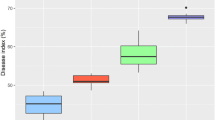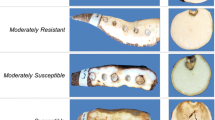Abstract
Cassava root rot disease is an increasing problem in Africa where yield losses of about 80% have been recorded. We evaluated 290 African landraces and 306 improved genotypes from the germplasm collections of the International Institute of Tropical Agriculture (IITA), for sources of resistance using root slice laboratory assay. Disease severity was assessed quantitatively by direct percentage estimation (PS) and by use of a rating scale (RS). Both methods of assessment were compared for identification of variability in the germplasm, and genotypes were classified into response groups using an enlarged rank-sum method that combined the PS and RS assessments. The two scoring methods revealed continuous variation (P < 0.001) for resistance in the sets of germplasm. Disease assessments based on PS and RS were highly correlated in both the improved germplasm (r = 0.75) and the landraces (r = 0.72). Based on PS assessment, 50 improved genotypes (16.3%) and 53 landraces (18.3%) showed significantly lower disease scores than the resistant control. The rank-sum method separated each set of collections into highly resistant, resistant, moderately resistant, moderately susceptible, susceptible and highly susceptible groups. Fifty-nine improved genotypes (16.4%) and 61 African landraces (16.9%) were identified as either highly resistant or resistant. Generally, these genotypes exhibited resistance by limiting the growth of the pathogen (reduced amount of invaded surface area). This type of rate-reducing resistance is highly heritable and a quantitative trait which can be harnessed in breeding. Genotypes subsets were identified for further studies into the genetic basis of resistance to root rot disease.
Similar content being viewed by others
References
Ariyo, O.A., A.G.O. Dixon & G.I. Atiri, 2002. The relative resistance of cassava cultivars to African mosaic disease (ACMD) as determined by two methods: Rank-sum and the area under the disease progress curve. Arch Phytopath Plant Protec 35: 23–30.
Barragan, M.I. & E. Alvarez, 1998. Evaluation of tolerance to root rot caused by Phytophthora spp. in varieties of cassava (Manihot esculenta crantz), under greenhouse condition. ASCOLFI-Informa 24: 11–12.
Campbell, C.L. & L.V. Madden, 1990. Introduction to Plant Disease Epidemiology, pp. 107–128. John Wiley & Sons, New York City.
Ceballos, H.N., C.A. Iglesias, J.C. Perez & A.G.O. Dixon, 2004. Cassava breeding: opportunities and challenges. Plant Mol Biol 56: 503–516.
Crossa, J. & J. Franco, 2004. Statistical methods for classifying genotypes. Euphytica 137: 19–37
Dorrance, A.E. & S. St. Martin, 2000. Pathogen population genetics and breeding for disease resistance. Phytophthora sojae: Is it time for a new approach? APSnet Feature Story July 2000. http://www.apsnet.org/online/feature/PathPopGenetics/dorrance.htm
FAO, 1993. Food production statistics. Food and Agriculture Organisation (FAO), Rome, Italy.
Forbes, G.A. & J.T. Korva, 1994. The effect of using a Horsfall-Barratt scale on precision and accuracy of visual estimation of potato late blight severity in the field. Plant Pathol 43: 675–682.
Fokunang, C.N., C.N. Akem, A.G.O. Dixon & T. Ikotun, 2000. Evaluation of a cassava germplasm collection for reaction to three major diseases and the effect on yield. Gen Res Crop Evolu 47: 63–71.
Hahn, S.K., J.C.G. Isoba & T. Ikotun, 1989. Resistance breeding in root and tuber crops at International Institute of Tropical Agriculture (IITA), Ibadan, Nigeria. Crop Protec 8: 147–168.
Happstadius, A., A. Ljungberg, B. Kristiansson & C. Dixelius, 2003. Identification of Brassica oleracea germplasm with improved resistance to Verticillium wilt. Plant Breed 122: 30–34.
Hau, B. & J. Kranz, 1990. Mathematics and statistics for analysis in epidemiology. In: J. Kranz (Ed.), Epidemics of Plant Diseases, pp. 12–52. Springer-Verlag, Berlin.
Msikita, W., B. James, M. Ahounou, H. Baimey, B.G. Facho & R. Fagbemisi, 1998. Discoveries of new diseases of cassava in West Africa. Trop Agric 75: 58–63.
Msikita, W., B. Bissang, B.D. James, H. Baimey, H.T. Wilkinson, M. Ahounou & R. Fagbemissi, 2005. Prevalence and severity of Nattrassia mangiferae root and stem rot pathogen of cassava in Bénin. Plant Dis 89: 12–16.
Onyeka, T.J., 2002. Cassava root rot pathogens in Nigeria: Variability in Botryodiplodia theobromae isolates and evaluation of the cassava germplasm collection for resistance to root rot disease. Ph.D. thesis, University of Ibadan, Ibadan, Nigeria.
Onyeka, T.J., E.J.A. Ekpo & A.G.O. Dixon, 2004. Cassava root rot disease in West Africa: Review of recent literature and the field situation in Nigeria. In: M.O. Akoroda (Ed.), The small processor and development of local food industries for market economy. Proceedings of the 8th Symposium of the International Society for Tropical Root Crops-Africa Branch (ISTRC-AB), 12–16 November 2001, International Institute of Tropical Agriculture (IITA), Ibadan, Nigeria, pp. 584–588. ISTRC-AB/IITA, Ibadan, Nigeria.
Onyeka, T.J., A.G.O. Dixon & E.J.A. Ekpo, 2005a. Field evaluation of root rot disease and relationship between disease severity and yield in cassava. Exp Agric 41: 357–363.
Onyeka, T.J., A.G.O. Dixon & E.J.A. Ekpo, 2005b. Assessment of laboratory methods for evaluating cassava genotypes for resistance to root rot disease. Mycopathologia 159: 461–467.
Parlevliet, J.E., 1993. What is durable resistance, a general outline. In T. Jacobs & J.E. Parlevliet (Eds.), Durability for disease resistance, pp. 23–29. Kluwer academic publishers, Dordrecht.
Peever, T.L., R.S. Zeigler, A.E. Dorrance, F.J. Correa-Victoria & S. St. Martin, 2000. Pathogen population genetics and breeding for disease resistance. APSnet Feature Story July 2000. http://www.apsnet.org/online/feature/PathPopGenetics.
SAS, 2000. SAS System for Windows, version 8. SAS Institute, Cary, NC, USA.
Tooley, P.W. & G.R. Grau, 1984. Field characterization of rate-reducing resistance to Phytophthora megasperma f. sp. glycinea in soybean. Phytopathology 74: 1201–1208.
Walker, A.K. & A.F. Schmitthenner, 1984. Heritability of tolerance to Phytophthora rot in soybean. Crop Sci 24: 490–491.
Author information
Authors and Affiliations
Corresponding author
Rights and permissions
About this article
Cite this article
Onyeka, T.J., Dixon, A.G.O. & Ekpo, E.J.A. Identification of levels of resistance to cassava root rot disease (Botryodiplodia theobromae) in African landraces and improved germplasm using in vitro inoculation method. Euphytica 145, 281–288 (2005). https://doi.org/10.1007/s10681-005-1646-8
Received:
Accepted:
Issue Date:
DOI: https://doi.org/10.1007/s10681-005-1646-8




